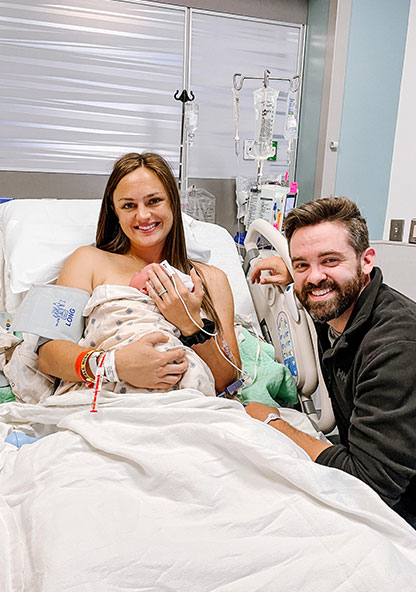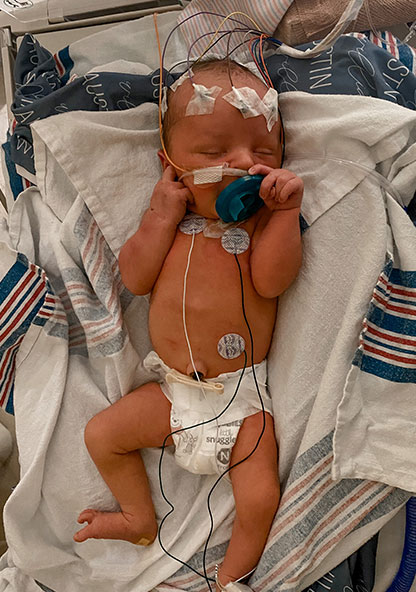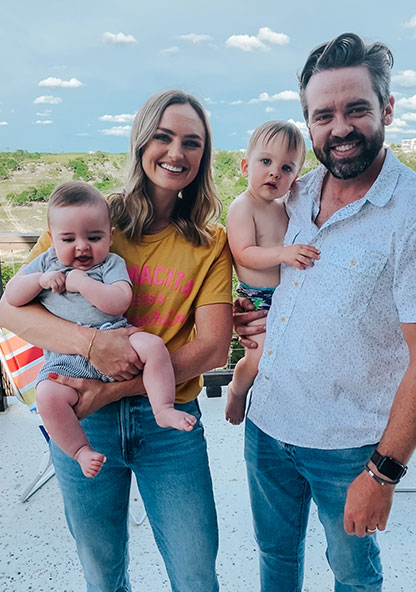William’s Story: Exceptional Care for a Rare Genetic Seizure Disorder
When Morgan and Austin Yount found out they were pregnant with their second child, they never could have imagined the challenges their son would face in the first few months of his life.
The couple already had a 15-month-old son, Charlie, and they were thrilled to welcome a younger brother into their growing family. After an uneventful and healthy pregnancy, William Yount was born on Oct. 22, 2022, at a hospital in San Antonio, TX.
But just a few hours after his birth, Morgan and Austin noticed that William was acting strange.
First Signs of Trouble
“It looked like he would hold his breath and produce a lot of saliva in his mouth, but I brushed it off as newborn behavior because our oldest son did similar things as a newborn,” Morgan said. “It didn’t really raise any red flags for me at first, but I did tuck it away in my brain as a little odd.”
The next day, however, he continued to seemingly hold his breath—to the point where he began turning purple. Morgan told the nurse, and she made a note of it, but at that point, nobody was too concerned because he seemed otherwise healthy.
On the day they were supposed to be discharged home, the nurse took William to perform his circumcision and to run some routine tests. During that time, he had another episode that the nurses were able to witness firsthand.
Rushed to the NICU
“The nurse agreed that it wasn’t normal, and she said that they wanted to hook him up to some monitors and have the pediatrician examine him,” Morgan said. “She took him back and not long after, we heard screaming for help in the hallway. I remember turning to my husband and I just had this sinking feeling that they were screaming about William.”
Morgan and Austin rushed out of the room to see a swarm of nurses and doctors running into the nursery, but they were still unable to determine if it was for their son. After what “felt like a lifetime of waiting,” Morgan said, a nurse came out and confirmed the worst—William had stopped breathing and had to be rushed to the NICU.
Once there, he continued to have more and more episodes in which he seemingly held his breath, turned purple from lack of oxygen, and would make rhythmic motions with his arms and legs.
“The biggest fear was that he was having seizures,” Morgan said. “But nobody really knew yet what was going on.”
Unexplained Episodes
In the NICU, Morgan and Austin were finally able to capture one of his episodes on video so a doctor could see it as it was happening. Concerned about what he saw, the doctor ordered an EEG to be performed immediately, even though it was nearing 3 a.m. at this time. An EEG, which stands for electroencephalogram, is a test that measures electrical activity in the brain using small electrodes attached to the scalp.
William’s EEG results confirmed Morgan and Austin’s worst fears: he was having seizures, as well as additional abnormal brain activity.
His doctors then sent him for an MRI, which showed what looked like an injury on the right side of his brain, possibly from a stroke in-utero. But because Morgan’s pregnancy had been uneventful, that explanation was not probable.
“They decided to run some genetic tests to see if that could be the cause, and they ended up doing a whole exome test where they looked at his entire DNA sequence,” Morgan said.
Transfer for More Specialized Care
After two weeks, his neurologist recommended the Younts transfer their newborn to CHRISTUS Children’s for more specialized testing and care.
CHRISTUS Children’s Neurosciences Center offers highly specialized evaluations, diagnoses, and treatments for various neurological conditions. The center’s medical staff provides the highest level of evidence-based epilepsy care including neurosurgical intervention.
“As soon as we transferred to CHRISTUS Children’s, we knew we were in the right place,” Morgan said. “The care team was immediately just incredible. William’s bed was just two feet away from the nurse’s station, and everyone listened to everything we had to say. They let us be extremely involved in his care, which was important to us.”
Finally Receiving Answers
After arriving at CHRISTUS Children’s, pieces began falling into place. The Younts received William’s genetic testing results showing that William had a rare condition. His brain injury was caused by a genetic mutation that occurred spontaneously and was not passed down by either parent.
In the NICU, William was placed under the care of Sowmya Mohan, MD, FAAP, who specializes in neonatal-perinatal medicine at CHRISTUS Children’s.
“Dr. Mohan was incredible,” Morgan said. “Even on her days off, she would come and check on William. She truly understood how important the continuity of care was for a patient like him and for a case this rare. She also checked in on my husband and me often to make sure we were doing OK. She cares so deeply for her patients and their families.”
Dr. Mohan and the team of neurologists worked together to adjust William’s medications to help control his seizures.
Episodes Continue at Home
On Nov. 21, 2022, one day before he turned 1 month old, he was able to go home.
It was a joyous time, but it was brief. Not long after, William’s seizures began worsening in both duration and frequency.
“Even with medication adjustments, it got to where he was having as many as 14 a day,” Morgan recalled.
The Younts were referred to epileptologist Gustavo Charria-Ortiz, MD, who specializes in epilepsy and is part of the pediatric neurology team at CHRISTUS Children’s.
“We arrived the very next day to see Dr. Charria, and he had already thoroughly reviewed William’s MRI and past medical history,” Morgan said. “He knew everything in detail — and it was a lot of information.”
Dr. Charria-Ortiz told the Younts that based on William’s condition, he highly recommended surgical intervention, and soon. Luckily, he knew one of the top doctors in the country for this type of surgery: Mark Lee, MD, Section Chief of Pediatric Neurosurgery at CHRISTUS Children’s.
“As scary as it is to hear your son needs brain surgery, it’s actually worse not having a plan and feeling helpless about what the future holds,” Morgan said. “Hearing that he recommended surgery actually gave us a lot of hope.”
Continued Care
William required another MRI before the surgery, but before that took place, his seizures grew even worse. After a call with one of their specialists at CHRISTUS Children’s, the Younts were advised to admit him for monitoring and around-the-clock care.
“When we got to the hospital, we didn’t even have to wait in the ER,” Morgan said. “We just walked up to the front desk, gave them William’s name, and they took us to the back where there were six people waiting for us.”
During that stay, William got the required MRI, and the Younts also had the opportunity to meet with Dr. Lee.
In Good Hands
“From the minute Dr. Lee came into the room, I just felt at peace,” Morgan said. “He walked us through the whole surgery — everything, and I just knew that William was in good hands and it was going to be OK.”
On Jan. 10, 2023, Dr. Lee and his team performed surgery on William. The goal of the surgery was to disconnect the damaged part of William’s brain from the rest of the brain in an effort to eliminate the source of the seizures.
Although Morgan and Austin were understandably nervous throughout the procedure, they had faith that William was exactly where he needed to be.
“Dr. Lee's team called us about every hour and a half and updated us on how William was doing,” Morgan said. “And the whole time, it was a good report. He just tolerated the surgery really well. Afterward, Dr. Lee came out and talked to us, and I just remember him looking at me and saying the surgery went very, very well, and I just lost it. It was such a relief.”
Successful Healing
Not only did the surgery go very well, but it was also successful. William hasn’t had a single seizure since the procedure.
“His recovery has been remarkable,” Morgan said. “He continues to be seizure-free, and he is doing things he wasn’t doing before the surgery, like making eye contact and smiling and babbling. Before the surgery, it was like he wasn’t fully present, and now he is so engaged and reaching milestones by working hard in physical and occupational therapy each week.”
Morgan said she believes that the power of prayer helped lead William to Dr. Lee and CHRISTUS Children’s, adding that her family will be forever in awe of his doctors’ expertise, compassion, and abilities.
“I just know that William is going to have a better quality of life because we were connected with this team, and we just couldn’t be more grateful to them and for God’s provision over William’s life,” Morgan said.
Dr. Lee said that William’s story is a perfect example of how a care team can work together to provide the best possible outcome for each patient.
"I am grateful to have been part of William's journey, and I commend the resilience of his family,” said Dr. Lee. “The successful outcome of the surgery and William's seizure-free life are a testament to the collaborative efforts of the care team at CHRISTUS Children’s. It's moments like these that reinforce our commitment to providing exceptional care and making a difference in the lives of our patients and their families."
To learn more about the Neuroscience Center at CHRISTUS Children’s, visit https://www.christushealth.org/locations/childrens-hospital/neurosciences-center.




